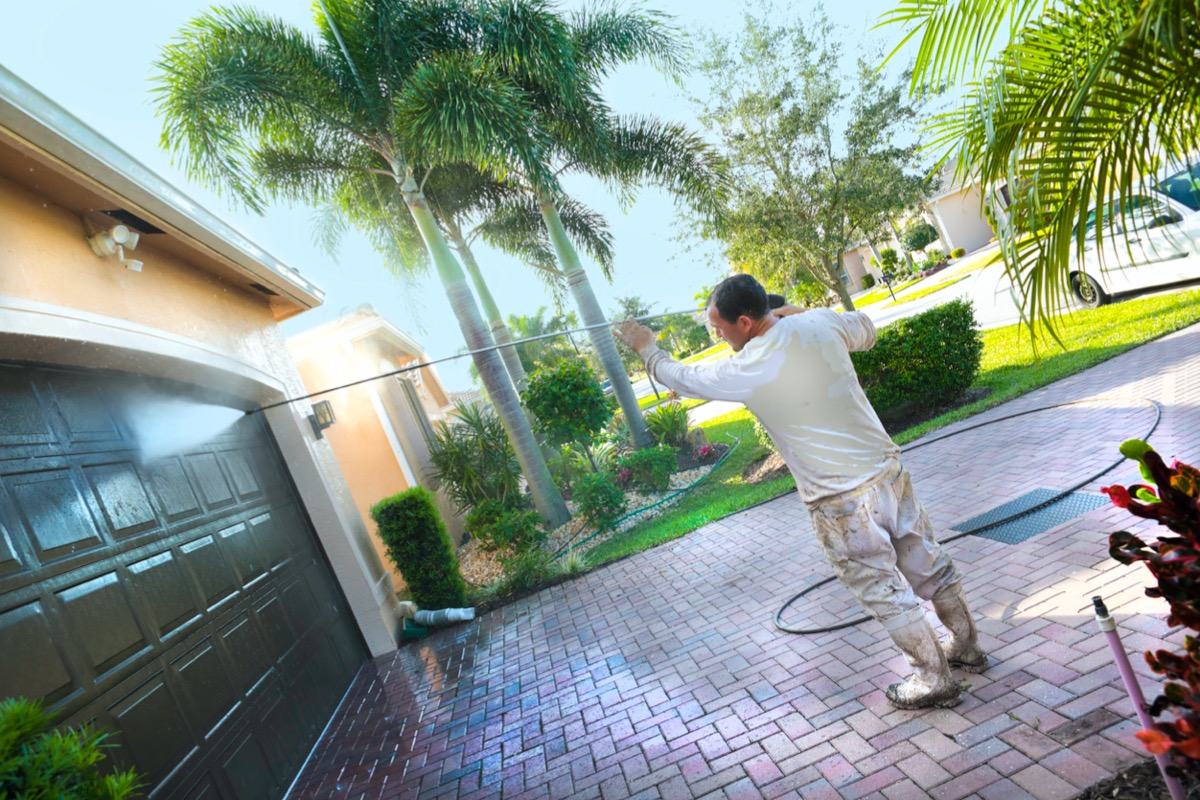

We may earn revenue from the products available on this page and participate in affiliate programs. Learn More ›
There may not be a magic wand to instantly banish years of mildew, soot, dirt, and grime from your home’s exterior, but pressure washing is the next best thing. The process is a terrific way to remove grime on your home’s traditional stucco, aluminum, steel, wood, and brick siding. Pressure washing can be performed every few years for general maintenance; it’s also necessary to prepare a home’s exterior before it is painted.
This task, however, is more involved than simply connecting your garden hose to a pressure washer and turning the water on. Pressure washing also takes some skill. Spraying too aggressively could harm siding or paint—in fact, pressure washing is not recommended for bottle-dash and rock-dash stucco or for fiber cement siding, all of which could be damaged by the process.
Pressure washing a home is risky if you do not follow the proper safety measures, and can be quite demanding physically. If it has been a long time since you last pressure washed your home you’re probably in for a lot of scrubbing by hand, and hours of reaching high and low on a vertical surface. If your home is taller than one story and you’re not up for standing on a scaffolding, you might consider hiring a pro for the job. For single-story homes, however, the steps below will guide you through how to pressure wash a house, and boost your curb appeal.
Before You Begin
Check the local weather report and choose a mild day in spring or fall for power washing. It’s a good idea to avoid washing in the strong summer sun, which could dry the cleaning agents before you are able to rinse them off. With a combination of proper cleaning products, scrubbing, good technique, and a thorough rinse, your home will soon be clean as a whistle once more.
Choosing the Right Pressure Washer
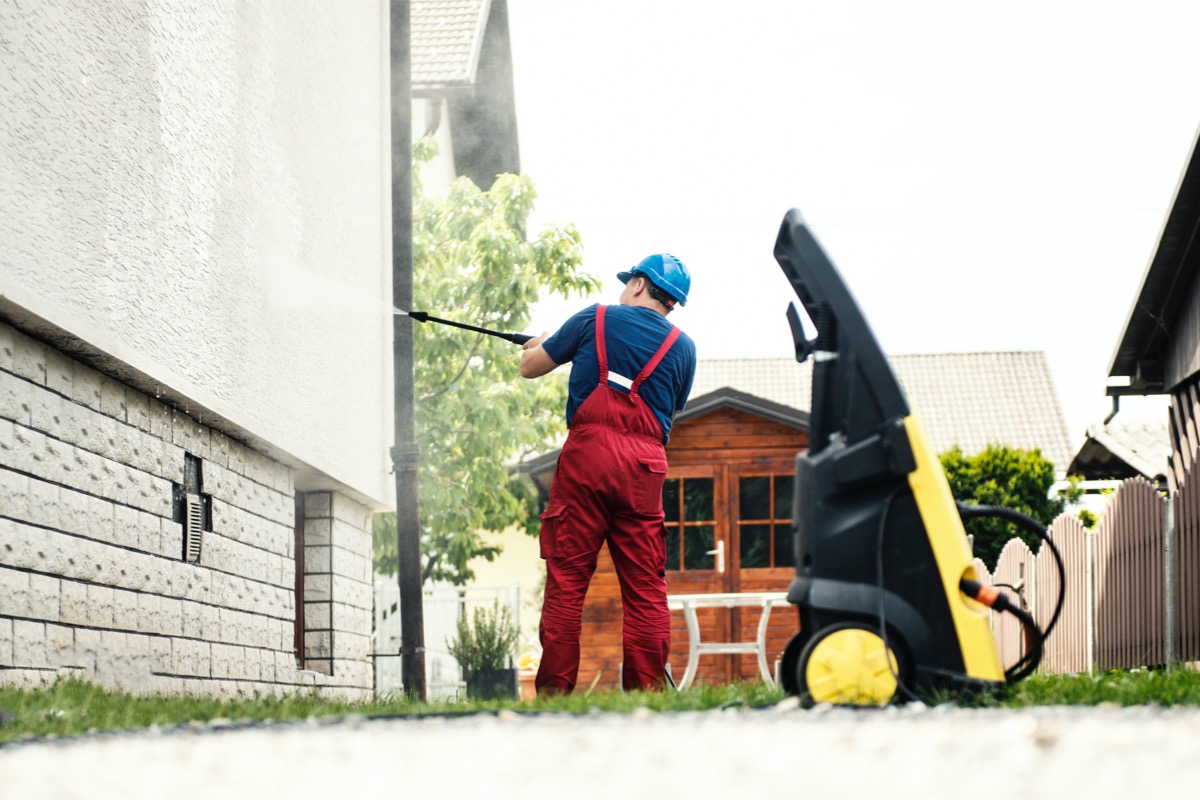
Pressure washers generate a high-pressure water spray that’s ideal for cleaning boats, sidewalks, decks, and houses. Their power is measured in pounds per square inch (psi), which is the amount of pressure the liquid contents put on the walls of the container. There are both gas and electric pressure washers available; the gas variety can create greater psi and is advised for tougher jobs and hardier material. Because they don’t have to be plugged into an electrical outlet, gas pressure washers are also more mobile, so they’re better suited for hard-to-reach areas.
If you plan to rent a machine, the rental agent will be able to recommend an appropriate pressure washer for your job. (Consult the machine’s manual, too, to make sure the psi works for your situation.) It’s also a good idea to ask the rental agent to demonstrate how to attach and detach nozzles from the spraying wand, and how to attach the extension wand. It’s worth noting that pressure washers are bulky and oftentimes quite heavy—some models weigh more than 100 pounds. You may need a helper and a truck to get the pressure washer home.
If you’re planning to purchase rather than rent a pressure washer, be sure to consult BobVila.com’s tested guide to the best pressure washers.
What’s the correct PSI for my home’s siding?
The psi required for building materials varies. Painted, soft-grain wood siding, stucco, and aluminum siding are best treated with 1,200 to 1,500 psi models. For delicate stucco, it’s also best to use a 25- to 30-degree wider spray nozzle to disperse water over a wider area and with less force, preventing any gouging or nicking. When power washing vinyl siding or other rugged, unpainted materials like brick, stone, and steel, it’s recommended to use a machine rated for 2,500 to 3,000 psi. Pressure washing fiber cement siding is not recommended and may void the siding’s warranty. If you opt to pressure wash this kind of siding, be sure to use less than 1,500 psi—and a wide nozzle.
Tools & Materials
Bobvila.com may earn a commission from purchases made through these links.
- Stiff deck-cleaning brush
- Garden sprayer
- Garden hose
- Safety goggles
- Pressure washer
- 6-foot to 12-foot extension wand
Pressure Washing Safety Precautions
- One mistake people make with a pressure washer is forgetting that the machines are powerful enough to tear off skin or cause blindness if sprayed at eye level. Never goof around with the equipment to spray a friend or use it to rinse your hands or feet.
- Water and electricity are a dangerous combination. Close any outdoor outlets or cover them with duct tape to prevent water from getting inside. Also be aware of any overhead power lines that could be struck by the extension wand, and be careful to avoid these as you work.
- Wear eye protection. Projectiles of dirt, rock, wood, or anything the water hits are a common hazard.
- Never use a ladder with a power washer. Washer recoil could propel you right off, even if you have a helper holding the ladder. Pros commonly use scaffolding because of the threat of recoil. If your home is taller than a single story and you are adamant about DIY-ing the job, rent, borrow, or buy (for about $200) a 6-foot rolling, lockable-wheel scaffold. With this, in combination with your reach and a 12-foot extension wand, you could manage to clean heights up to 24 feet.
7 Steps to Pressure Washing a House
Follow the steps below, which start with spraying your house using a common garden sprayer and then move on to a pressure washer, to rid your home’s exterior of built-up grime.
Step 1: Cover surrounding greenery and seal doors and windows.
Cover plants and shrubbery with drop cloths or plastic sheeting. Close windows and doors, and duct tape or cover with plastic sheeting if your doors and windows are prone to leaking Secure all sheeting/cloths with duct tape.
Step 2: Prepare your house washing solution.
In a 5-gallon bucket, mix the mildewcide with water according to the manufacturer’s directions. Add bleach at a volume of one part for every nine parts of the mildewcide-detergent solution. Pour this solution into the garden sprayer.
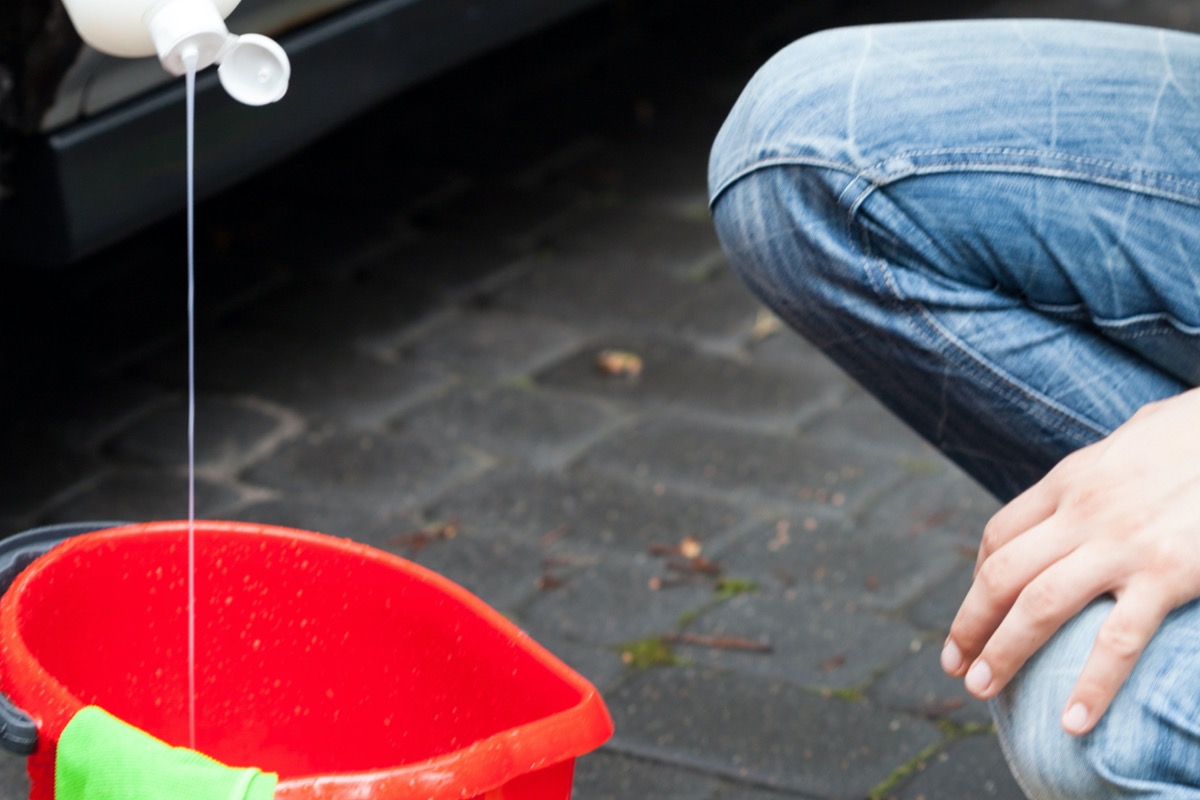
Step 3: Fit your pressure washer with the proper nozzle and prepare for action.
Set up the pressure washer so it will be ready to go when you’re finished with the garden sprayer and scrubbing. Locate the hose mount on the back of the pressure washer. Attach the garden hose to this mount, making sure that the other end is attached to the spigot outside of the house.
For harder surfaces and a higher psi, use a 15-degree spray nozzle. For softer surfaces and a lower psi, choose a 25- or 30-degree nozzle. If you’re washing a two-story structure, begin at the top and work your way down; you’ll probably need to attach the extension wand to reach the upper floor.
If you’re using scaffolding to reach the second floor, set it up according to the manufacturer’s instructions. Position the scaffolding far enough from the siding that you have a 1.5- to 3-foot reach with the wand held comfortably in your hand. Remember to lock the scaffolding’s wheels in position before using it.

Tried-and-True Advice
“While it’s not always strictly necessary, I have found treating the affected area with a good cleaner to be an essential step in pressure washing a house. For heavy algae and mold buildup, this solution can consist of mildewcide and bleach, as this article recommends, but for lighter dirt and grime I have found that a simple combination of household liquids—whether vinegar and dish soap or hydrogen peroxide—can do wonders. With the right cleaning, you can soften the dirt and grime to the point that it needs only a light “softwashing” to remove, which in the long run means less wear and tear on your home exterior.”
—Chase Brush, Contributing Writer
Step 4: Spray and scrub siding from bottom to top, working in 10-foot-wide sections.
Thoroughly spray a section of a single floor of your home with the mildewcide solution. Starting from the bottom of the section and working your way up, gently but firmly scour the siding with a soft siding brush. (Working your way up is recommended because suds will run down the wall if you start at the top, and it’ll be harder to see dirt and debris that needs to be scrubbed off.) If you’re washing a two-story home, start scrubbing the top story first, but work your way up from the scaffolding’s “floor” to the top of the house.
Step 5: Don your goggles and do a pressure wash test on the scrubbed area.
Once the first section is thoroughly scrubbed, put on the safety goggles. Make sure that you have a 3-foot nozzle-to-wall distance, then turn on the pressure washer. If this distance allows you to remove dirt without damage, maintain it. If dirt isn’t coming off, move closer in increments of 4 to 6 inches, stopping each time to gauge the cleaning power and check for damage. Continue to work from the distance that is most effective.
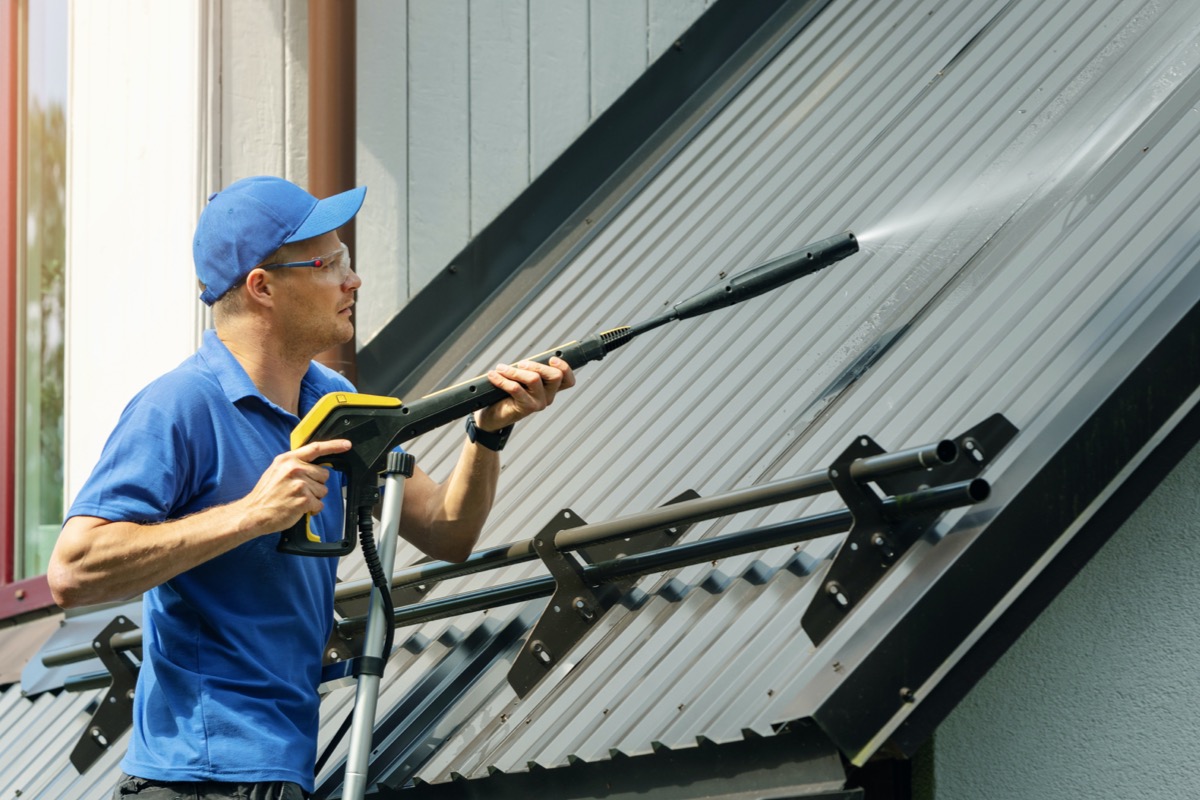
Step 6: Work from top to bottom, power washing the scrubbed section.
Once you’ve established an appropriate distance from the siding, begin power washing from the top of the scrubbed section. Spray overhangs and gutters first and work your way down. To prevent water from getting under the siding, reach up with both arms (as high as you can safely without recoil knocking you off balance), and angle the sprayer down at a 45-degree angle.
Step 7: Repeat Steps 4 through 6 until you’ve washed the whole house.
Move on to the next section of siding, repeating Steps 4 through 6 until you’ve cleaned the entire home. When you’re finished, pull up the drop cloths and plastic sheeting, toss the duct tape out, and put the cleaning agents and equipment away. If you plan to paint the home afterward, wait at least 2 days for the exterior to dry thoroughly. If not, step back and admire your sparkling clean home.
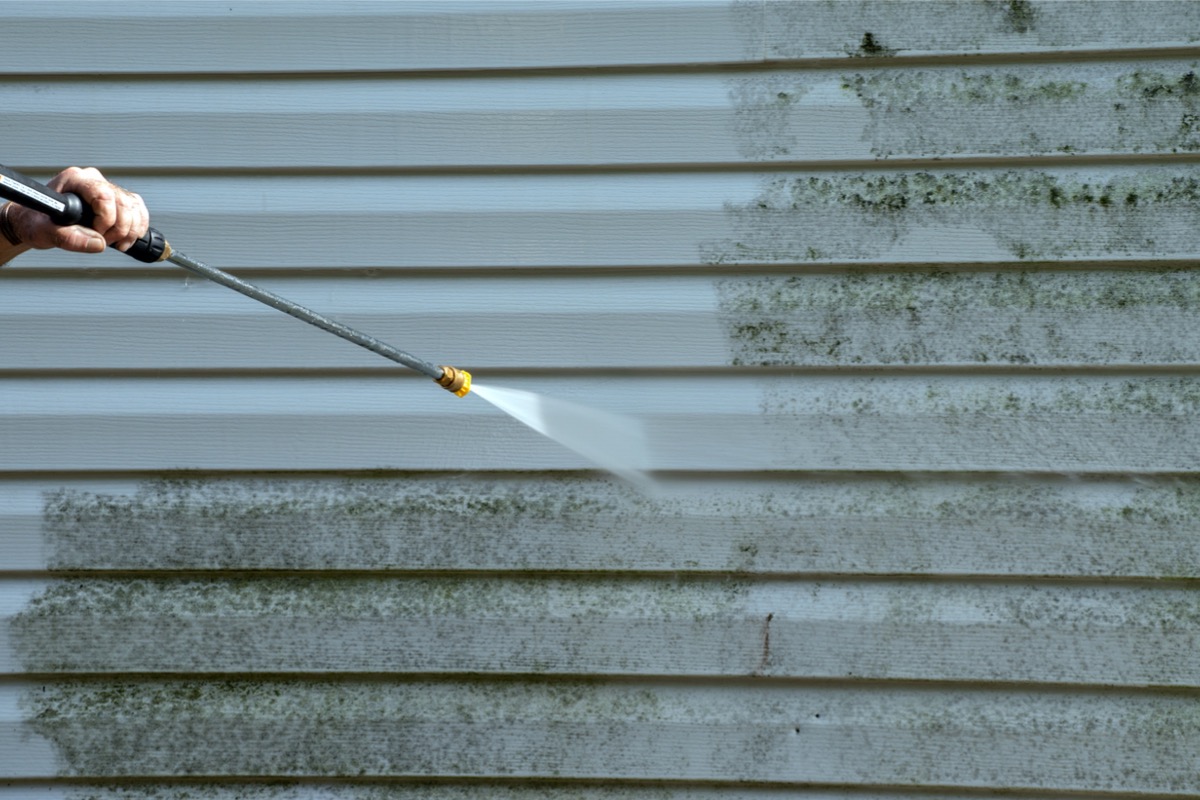
How much does it cost to pressure wash a house?
The good news is that water, generally, is fairly cheap, as in less than a penny a gallon. There are a number of variables, but assuming you use about 250 gallons of water to pressure wash your house, that would be somewhere around $1.25 worth of water. You can extrapolate water costs for higher usage.
Regional pricing varies, but a half-day pressure washer rental will cost you somewhere around $30. Most households probably have many of the other required materials already on hand, but assuming you don’t, you’ll spend about $200 on these items. So that brings your total to around $231.25. Again, you may already have a hose, bucket, and some sort of scrub brush, but we’re looking at a worst-case scenario.
On the other hand, professionals charge anywhere from 10 to 80 cents per square foot to pressure wash a home. If you’re thinking of hiring the job out, estimate your square footage before you start making calls.
Final Thoughts
You may have assumed that pressure washing is a cakewalk, but as you’ve discovered, cleaning your home’s exterior safely and effectively requires good technique and a fair amount of elbow grease. Following the steps carefully will ensure that your house is dirt and mildew free when you’ve finished the chore. Be sure you assemble all necessary materials before you start; take the time to protect plants, doorways, and windows; scrub the siding; and then start pressure washing. If you’re planning to paint, remember to time the washing properly so the siding can dry for a couple of days before you start applying paint or stain.
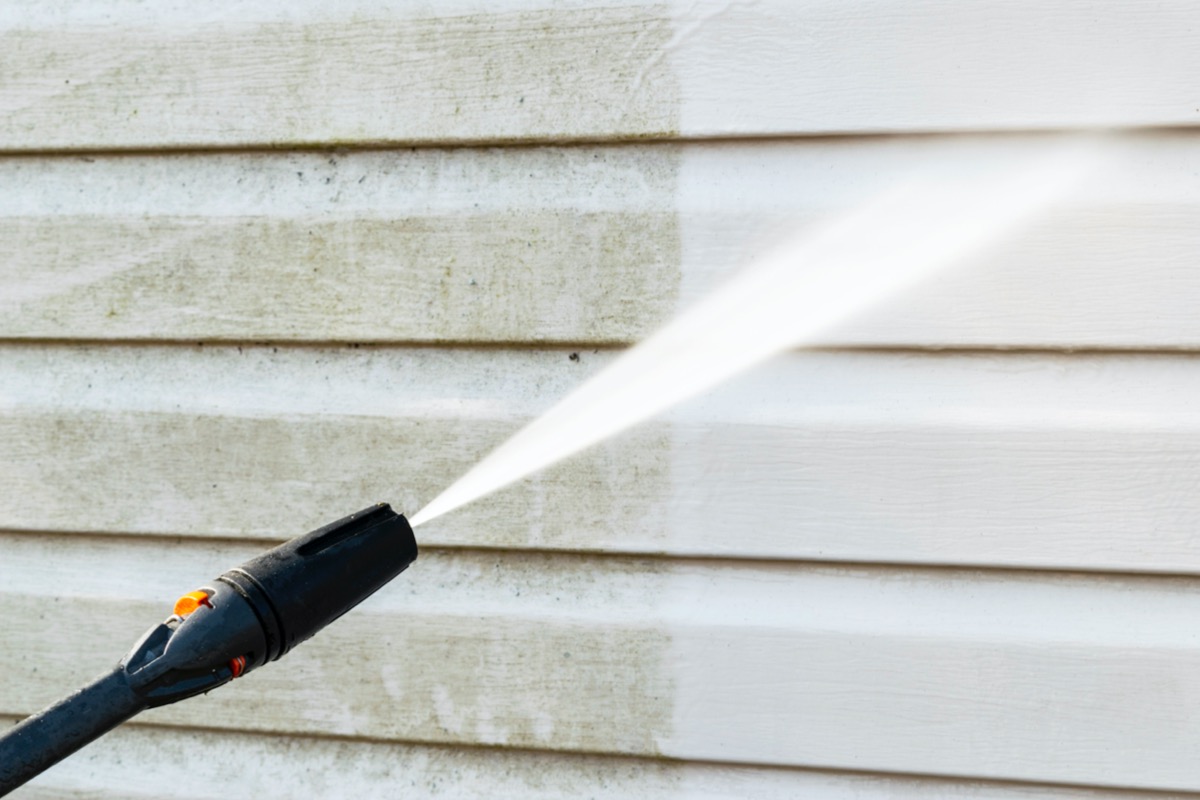
FAQs
In short, yes, you should pressure wash a house before painting it. Even if the exterior appears to be clean, it is almost certainly quite dirty, and paint will not adhere well to a dirty surface. What’s more, if you don’t wash the house first, you’ll trap all kinds of built-up grime and dirt in the paint, and your expensive, time-consuming paint job won’t look good.
There are a number of commercial pressure washing solutions available, or you can make your own solution. To keep it truly simple, just squirt dish soap into a bucket of warm water and mix thoroughly. For vinyl siding or painted homes, you can add vinegar for extra cleaning power.
You can pressure wash most types of stucco, provided you take steps to protect the delicate surface. If your machine offers a lower gallons-per-minute setting, choose that, and set a fairly wide spray radius so pressure on the siding is dispersed. More delicate types of stucco, such as bottle-dash and rock-dash stucco, should not be pressure washed.
It can take 30 minutes to 3 hours or more to pressure wash a house, depending, of course, on how large the house is. A 2,500-square-foot one-story home might take around an hour, for example.
Depending on the supplies you have on hand and whether you have to rent a pressure washer or already have one, it may cost around $200 to pressure wash a 2,500-square-foot home.
